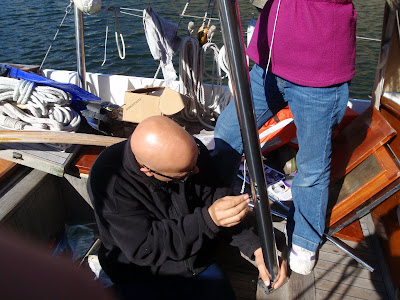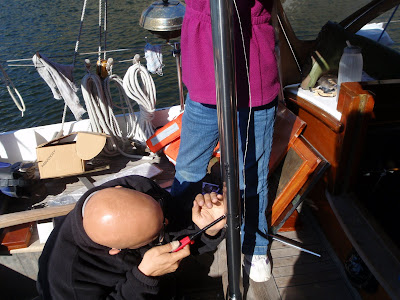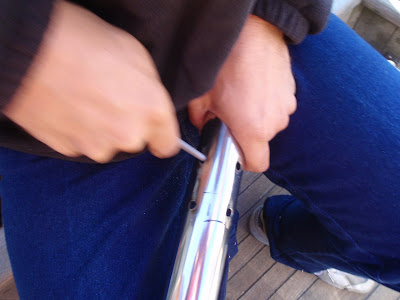I guess the lesson in this is that as soon as you yourself get your windvane set up, snap a digital photo and send it to Yves. He will very likely have some suggestions to improve your set up. He very much wants your vane to work perfectly, and unlike some companies who sell products they haven't actually used, Yves has the experience it takes to actually help you. Am I a fan? Well, have you ever had a company look you up on the web and check out how you are using their product and then emailing you with a fix for the problem you are having? First time for me.
Tuesday, December 16, 2008
Installing Windvane Self Steering Gear Part 10 - 223
Thursday, December 11, 2008
Installing Windvane Self Steering Gear Part 9 - 218
Note: If you have been referred here by another site,
this is only part of a multipart series.
 Once you drill the holes in the mounting tube and the windvane tower you have a little bit of a problem. You have a long tube with holes in it, and you have backing plates and screws - but you do not have a way to get the backing plates in the tubes. This calls for a little of what Gollum calls "getting tricksy". This part of the job is definitely a two person task. Take a string and tie a nail to it. Drop the nail through the tube end to end and then tie the backing plate to the string that is now through the tube. Cap Horn supplies some double sided tape so that the backing plate will stay in place once you line it up an get a screw in place, but it didn't help me. Once you line up the plate with one of the holes, put a screw in it without putting your strut in place. Now remove the string. What I did was take my lighter and burn the string off the plate. Now, put your strut mount over the second hole sideways (leaving the first screw in for now). Put your second screw in through the strut mounting plate into the backing plate. Now remove the first screw and turn the strut mounting plate so that it lines up with the second hole and backing plate. Now thread the second screw through the strut mounting plate into the backing plate.
Once you drill the holes in the mounting tube and the windvane tower you have a little bit of a problem. You have a long tube with holes in it, and you have backing plates and screws - but you do not have a way to get the backing plates in the tubes. This calls for a little of what Gollum calls "getting tricksy". This part of the job is definitely a two person task. Take a string and tie a nail to it. Drop the nail through the tube end to end and then tie the backing plate to the string that is now through the tube. Cap Horn supplies some double sided tape so that the backing plate will stay in place once you line it up an get a screw in place, but it didn't help me. Once you line up the plate with one of the holes, put a screw in it without putting your strut in place. Now remove the string. What I did was take my lighter and burn the string off the plate. Now, put your strut mount over the second hole sideways (leaving the first screw in for now). Put your second screw in through the strut mounting plate into the backing plate. Now remove the first screw and turn the strut mounting plate so that it lines up with the second hole and backing plate. Now thread the second screw through the strut mounting plate into the backing plate. 
Here my daughter Bianca pulls the string up and down to line up the holes.
Sorry about the glare from my head.

I used a small nail to help line up the backing plate before I put the first screw in.

Just as you think you have it all lined up something moves.

I use my lighter to burn the string off of the plate. I already have one screw threaded in.
Tuesday, December 09, 2008
Installing Windvane Self Steering Gear Part 8 - 216
Note: If you have been referred here by another site, this is only part of a multipart series. To see the rest of the story click here and start from the bottom.
 The next step in installation is mounting the unit to the boat. This is only difficult if you haven't spent the time to figure out exactly where everything is supposed to go beforehand. It will also be difficult if you do not have sharp drill bits. My 5/16th drill bit was in good shape, I had only drilled wood with it up to this point didn't survive the process of drilling all the holes for the support struts. Fortunately, I had a spare tungsten carbide drill bit that barely made it to the end of the job and required replacement when I was done. The steel used in building the wind vane is 316 stainless. This is a very corrosion resistant high grade steel. Most of the stainless that I have been used to working with is 304. 304 is much softer than 316. There are also differences between the foundries that make 316, and the steel on the Cap Horn is highly polished and very hard. It will eat at least two of the highest grade drill bits you can buy.
The next step in installation is mounting the unit to the boat. This is only difficult if you haven't spent the time to figure out exactly where everything is supposed to go beforehand. It will also be difficult if you do not have sharp drill bits. My 5/16th drill bit was in good shape, I had only drilled wood with it up to this point didn't survive the process of drilling all the holes for the support struts. Fortunately, I had a spare tungsten carbide drill bit that barely made it to the end of the job and required replacement when I was done. The steel used in building the wind vane is 316 stainless. This is a very corrosion resistant high grade steel. Most of the stainless that I have been used to working with is 304. 304 is much softer than 316. There are also differences between the foundries that make 316, and the steel on the Cap Horn is highly polished and very hard. It will eat at least two of the highest grade drill bits you can buy.

 Now you take a fine rat tail or round file and deburr the holes that you have drilled. I elongated one pair of holes and widened the other pair of holes. In this way when mounting the unit I could match the two struts that attach to these holes in both axis of movement.
Now you take a fine rat tail or round file and deburr the holes that you have drilled. I elongated one pair of holes and widened the other pair of holes. In this way when mounting the unit I could match the two struts that attach to these holes in both axis of movement.
 The next step in installation is mounting the unit to the boat. This is only difficult if you haven't spent the time to figure out exactly where everything is supposed to go beforehand. It will also be difficult if you do not have sharp drill bits. My 5/16th drill bit was in good shape, I had only drilled wood with it up to this point didn't survive the process of drilling all the holes for the support struts. Fortunately, I had a spare tungsten carbide drill bit that barely made it to the end of the job and required replacement when I was done. The steel used in building the wind vane is 316 stainless. This is a very corrosion resistant high grade steel. Most of the stainless that I have been used to working with is 304. 304 is much softer than 316. There are also differences between the foundries that make 316, and the steel on the Cap Horn is highly polished and very hard. It will eat at least two of the highest grade drill bits you can buy.
The next step in installation is mounting the unit to the boat. This is only difficult if you haven't spent the time to figure out exactly where everything is supposed to go beforehand. It will also be difficult if you do not have sharp drill bits. My 5/16th drill bit was in good shape, I had only drilled wood with it up to this point didn't survive the process of drilling all the holes for the support struts. Fortunately, I had a spare tungsten carbide drill bit that barely made it to the end of the job and required replacement when I was done. The steel used in building the wind vane is 316 stainless. This is a very corrosion resistant high grade steel. Most of the stainless that I have been used to working with is 304. 304 is much softer than 316. There are also differences between the foundries that make 316, and the steel on the Cap Horn is highly polished and very hard. It will eat at least two of the highest grade drill bits you can buy. The first step in drilling is making sure you have the positions for all the pieces right.
The next step in drilling is taking a break and remeasuring all the positions.
The third step in drilling is to take a punch and dent the exact spot where you want the hole. Without the dent you will chase your spot around and end up scratching your beautiful mounting tube.
The fourth step is to drill the hole.

The drilling goes easy with a sharp bit and a good dent where you want it. If you are having trouble you are doing something wrong. I did all the work in the cockpit of my boat. It is more hassle than setting up in a work shop, BUT as soon as you start working away from your boat you lose situational awareness and get mixed up and drill things in the wrong spot. I suppose you could set up in a work shop vice after you center punch your drilling spots, but the final steps should be done in the cockpit.

Next step: Getting the backing plates in.
Tuesday, December 02, 2008
Portland Pudgy Part 5 - 209
Note: If you got here by another web site or referral, this is only part of a series. See the entire series. Click here and start from the bottom.
 When the mother ship is tied up at a slip I need a sailing fix. The sailing rig on the Pudgy does just that for me. It takes me less than five minute to rig the Pudgy for sailing, and the best part is that the entire sailing rig fits inside the watertight storage compartments inside the dingy. Sailing also beats rowing from the way out anchorage or mooring field.
When the mother ship is tied up at a slip I need a sailing fix. The sailing rig on the Pudgy does just that for me. It takes me less than five minute to rig the Pudgy for sailing, and the best part is that the entire sailing rig fits inside the watertight storage compartments inside the dingy. Sailing also beats rowing from the way out anchorage or mooring field.

 When the mother ship is tied up at a slip I need a sailing fix. The sailing rig on the Pudgy does just that for me. It takes me less than five minute to rig the Pudgy for sailing, and the best part is that the entire sailing rig fits inside the watertight storage compartments inside the dingy. Sailing also beats rowing from the way out anchorage or mooring field.
When the mother ship is tied up at a slip I need a sailing fix. The sailing rig on the Pudgy does just that for me. It takes me less than five minute to rig the Pudgy for sailing, and the best part is that the entire sailing rig fits inside the watertight storage compartments inside the dingy. Sailing also beats rowing from the way out anchorage or mooring field. How does it sail? It sails like a bathtub with a mast. Maybe a little better. We do not have the performance dagger boards, and I hear that they help the sailing characteristics tremendously. The present dagger boards are set up more for the self rescue option, I think. It is a stable sailboat, it really likes winds in the 15-20kt range. Below 8 kts of wind and I can row faster, although I usually don't because it is easier to use the wind and I am not in a rush. It is a fun boat to sail though, and simple enough that my girls can sail it. It is stable enough that I don't have to worry about them in the Pudgy alone.
The sailing kit is the main reason we do not have an outboard motor for our Dingy yet. The sailing kit also makes the Pudgy a viable self rescue craft.
Next up: The Liferaft Option
Subscribe to:
Posts (Atom)
